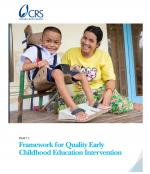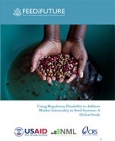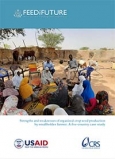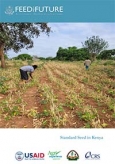Guidelines | February 7, 2022
CRS Framework for Quality Early Childhood Education (ECE) Intervention
This CRS Framework for Quality Early Childhood Education (ECE) (ECE Framework) aligns with and reflects CRS’ Global Education Conceptual Framework, which recognizes that for all children to learn and thrive, they must be healthy, safe, engaged, supported and resilient as they grow and develop. It is also a key part of the strategic priority areas within CRS education sector to support all children holistically in physical, cognitive, language, social, emotional, moral and spiritual development, in addition to a continued focus on other essential needs of young children such as responsive caregiving, health, nutrition and protection.
The ECE Framework focuses on learners/young children within the preprimary age range of 3–5 - aligning with, and bridging between, CRS’ IECD Framework for ages 0-2 and the early primary level. By doing so, this framework facilitates efficiency in CRS’ early childhood programming by securing gains made through investments during the first 1,000 days (prenatal through ages 0–2), and ensuring continuity of quality ECE program for the preprimary age group starting from age 3 until the child enters first grade with a goal: All young children enter primary school healthy, and ready to learn and succeed. Therefore, the purpose of this ECE framework is to support CRS program staff with the process of helping partners ensure quality ECE programs for ALL young children by: 1) facilitating a holistic early childhood intervention across the development and learning continuum and 2) making and implementing relevant choices on how to best invest in ECE programs at the preprimary level in the context of their country’s socioeconomic and cultural situations.
The four-part ECE Framework provides CRS program staff with information, which they can leverage for proposal preparation and/or designing, implementing and evaluating quality ECE programs for young children ages 3–5. Part 1 provides evidence on the impact of ECE and core ECE principles/philosophies that guide the theory of change (TOC) and the conceptual model of this framework, which is represented and described by a set of Building Blocks for quality ECE—integral components that work together to address the development and learning needs of children from diverse backgrounds. Part 2 presents key example interventions strategies with related activities and resources that can be used to support parents, communities, ECE staff and all stakeholders to strengthen ECE programming. Part 3 presents spotlights from CRS country programs as examples of how the building blocks and interventions have been contextualized in specific country contexts. Part 4 provides a literature review on ECE, with additional resources. Below are these four parts of the ECE Framework:
- Background
- Early childhood education overview
- Guiding principles
- CRS Conceptual Framework/Building Blocks and TOC for quality early childhood education intervention
- Section 1. Intervention platform: family (household)
- Section 2. Intervention platform: facility (ECD program, e.g., ECE center)
- Section 3. Intervention platform: community (faith leaders, local leaders, community groups or councils)
- Section 4. Intervention platform: institution (government body – ECE sector and others hosting ECE)
- Section 5. Monitoring and evaluation
- Section 6. Cross-cutting elements in ECE: Broad strategies in: Early Education in Emergencies. Protection. Gender. Disability. Minority Language. and Technology.
PART 3: SPOTLIGHT: CRS EARLY CHILDHOOD EDUCATION PROGRAMS
- Burkina-Faso. Cambodia. Egypt. Lesotho. Laos-PDR.
PART 4: ANNEX: BACKGROUND LITERATURE REVIEW ON EARLY CHILDHOOD EDUCATION (ECE) WITH RESOURCES





